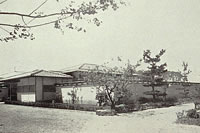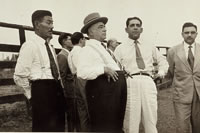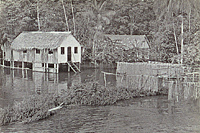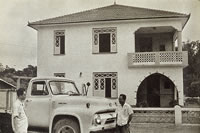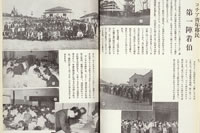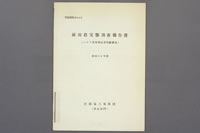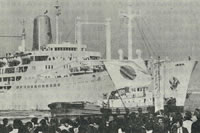Reintegration of the colonists
Committee for the quadricentennial cerebration of the City of São Paulo
Toward the quadricentennial cerebration of the city of São Paulo in 1954, as it was announced from around May 1952 onwards that other country’s colonias made plans to participate in it, some plans were made also in the Japanese Colonia. The split among the Japanese community, however, had still continued to exist, and there was no organization representing the whole colonia. With the restoration of diplomatic relations between the two countries, the Consul General of Japan in São Paulo began operations again, but as a result of its long absence of ten years during and after the war the consulate had lost its connection with the Colonia and became nothing more than a diplomatic establishment abroad. Of the big three organizations that led Japanese immigrants before the war, the Kaigai Kogyo Kabushiki Gaisha (Overseas Enterprise Company Limited) had lost its influence even before the war, and Brataku, other than the Nanbei Ginko (Bank of South America) which had grown from a branch of Brataku, existed in name only.
It was in this context that the Japanese Committee for quadricentennial ceremony of the City of São Paulo was formed on December 8, 1954, under the leadership of Kiyoshi Yamamoto, the director of the Tozan Nojo (Tozan Farm), and became the first unified organization for the Japanese colonia. Thus the São Paulo City Japanese community took the lead in the participation in the quadricentennial ceremony of the city of São Paulo, through which participation the Japanese community to once again become whole through.
Brazilian Society of Japanese Culture at São Paulo
After the dissolution of the Committee for the quadricentennial cerebration of the city of São Paulo on October 15, 1955, the Brazilian Society of Japanese Culture at São Paulo (abbreviated as "Bunkyo" from the Japanese name "Nihon Bunka Kyokai") was founded on December 17, 1955. In November of 1956, the Preparation Committee for the 50th Anniversary Celebration was formed, mainly by the Brazilian Society of Japanese Culture at São Paulo. It held the 50th anniversary ceremony in 1958, and conducted the colonia survey as a project commemorating the 50th anniversary, and constructed the Japanese Culture Center (the current "Bunkyo Building") (the first stage of the building's construction was completed in April 1964).
In May 1967, Crown Prince Akihito of Japan and Crown Princess Michiko visited Brazil, and a reception committee was formed under the leadership of Bunkyo, and the reception brought great joy to the Japanese Colonia. In June 1978, on the occasion of the celebration of the 70th anniversary of Japanese immigration to Brazil, the History Museum of Japanese Immigration to Brazil was founded inside the Brazilian Society of Japanese Culture Building.
-
 Birth of the Japanese pavilion
Birth of the Japanese pavilion -
Articles in newspapers / magazines
First visit of the Crown Prince and the Crown Princess Michiko to Brazil
Postwar emigration
Resumption of emigration – Matsubara emigration and Tsuji emigration
While the number of Japanese soldiers who were demobilized and sent home and Japanese civilians who were repatriated from its former colonial territories exceeded six million by 1950, only agriculture jobs and small stores, small businesses and day labor jobs in urban areas were available, and the resumption of emigration to Brazil was eagerly awaited.
On July 1, 1952, the then President Getulio Vargas authorized Yasutaro Matsubara, with whom he had a friendly personal relationship, to bring immigrants within the limit of 4,000 families to central Brazil, and Kotaro Tsuji, former executive director of the Amazonia Industrial Research Center which had achieved jute production to brng immigrants within the limit of 5 thousand families to northern Brazil. Based on these authorizations, on February 11, 1953, the Tsuji emigration consisting of 18 families, 54 persons arrived at the port of Santos to cultivate jute in the Amazon River basin (on the condition that they would work for Japanese families already settled in the region) and on July 7, landed the Matsubara emigration consisting of 22 families, 112 persons arrived at the port of Santos to be settled the Dourados colony (in the State of Mato Grosso).
The biggest obstacle to the resumption of immigration was the travel expenses, which was removed by the Japanese Government measures to loan money to emigrants (with a 5 year grace period and total 15 years to repay the loan in equal annual installments).
The July 1 arrangement
Matsubara and Tsuji respectively concluded an arrangement with Brazilian Ministry of Agriculture, Agency for Immigration and Colonization (the July 1 arrangement). The numbers of settlers to the northern part of Brazil within the limit authorized to Tsuji were 315 families, 1,036 persons from 1953 until the immigration agreement between Japan and Brazil came into force in 1963, and the number of settlers to central and southern Brazil within the limit authorized to Matsubara were 202 families, 1,073 persons and 158 single persons, a total of 1,231 persons between 1953 and 1961. The standard post war emigration was not hired emigrants (colonos), but rather individual emigrants who settled in a colony run by the Brazilian Federal Government or a state government.
In addition to the Matsubara and Tsuji emigration, the following emigration projects were also carried out.
Silk farming emigration
The resumption of immigration was not supported positively in São Paulo where the memory of the terrorist attacks remained fresh. The Paulista Silk Farming Association, however, of which 90% of the members were Japanese silk farmers, planned the introduction of immigrants skilled in silk farming to further develop silk farming industry in the State. As a result of lobbying by persons concerned, the association was permitted to receive those immigrants from 1954 onwards. By 1959, 200 families, 1,251 persons emigrated, and when the second set of silk farming emigrants consisting of 63 families, 367persons emigrated in 1960 and 1961, the project was discontinued due to a remarkable decrease in the number of applicants. The Japanese Government also provided loans to these emigrants to cover travel expenses.
Cotia Youth Emigration
The Cotia Agricultural Cooperative carried out a plan for bringing Japanese immgrants to resolve a shortage of skilled workers in rural areas and especially for horticulture farming in the outskirts due to the post-war shift of rural population to urban areas. According to the plan, the Cotia Agricultural Cooperative should be an authorized immigration broker, conclude an agreement with the Nippon Kaigai Kyokai Rengokai (Federation of Japan Overseas Associations, abbreviated as "Kaikyoren") and the Central Union of Agricultural Cooperatives, which the Kaikyoren should entrust with the selection and recruitment of emigrants, should select and recruit young unmarried emigrants from mainly the 2nd and 3rd sons of farming families, and Cotia Agricultural Cooperative members should become patrons for these selected emigrants, which should conclude a labor contract between the emigrants and the Cooperative member stating that the emigrant should live together in the patron's house and work for the patron for four years at least, with meals, and then receive support from the patron to become independent.
In January 1955, the Agency for Immigration and Colonization authorized the Cooperative to bring of 1,500 immigrants within 3 years, and on September 15, 1955, the first party of 109 immigrants arrived in Santos, and the first set of 1,500 immigrants took a voyage to Brazil by August 1958. Afterwards the second set of 1,500 immigrants was authorized and a total of approximately 2,300 immigrants took a voyage to Brazil by January 1967.
The Industrial Development Youth Corps
Although from 1953 onwards the Ministry of Construction committed the Industrial Development Youth Corps as field engineers to domestic comprehensive development projects of the national land in Japan, a new plan to ship this corps overseas was made. In June 1956, the first seventeen engineers of the Youth Corps took a voyage to Brazil, with the help of the Cotia Agricultural Cooperative, as immigrants sponsored by the Brazilian Immigration and Colonization Company and received a contract of route surveying, road construction and forest clearing on land owned by the company in Serra dos Dourados in the State of Parana. On October 17, 1957, the Central São Paulo Association of Agricultural Development Cooperatives was established as a sponsor organization for the Youth Corps, and in 1958, a training center was constructed in Serra dos Dourados in the State of Parana to ensure the smooth implementation of construction related to local projects, agricultural civil engineering and farm management. Ten groups of 301persons took a voyage to Brazil from 1956 until 1965 as members of the Industrial Development Youth Corps.
Tozan Farm agricultural trainees
The Tozan Farm agricultural trainees were agricultural trainees for one year or one and a half years in the Tozan Farm, located in Campinas in the State of São Paulo, which took on graduates from agricultural high schools and agricultural colleges as such trainees and helped them get a job on a farm after the completion of their training period. Three groups of 60 individuals took a voyage to Brazil from 1958 until 1962 as Tozan Farm agricultural trainees.
Industrial engineer emigration
With the industrialization of Brazil and the advancement of Japanese companies to Brazil, the emigration of Japanese industrial engineers and technicians ("engineer emigration", later referred to as "industrial engineer emigration") took place. 16 engineers employed by Gasparian Textiles in the State of Rio de Janeiro in 1953 were the first engineer emigrants. Howa Industry Co. Ltd which constructed a textiles plant in Mogi das Cruzes City in the State of São Paulo and began to recruit immigrants from 1957 accepted the largest number of, more than 200 engineer emigrants, over the course of approximately twenty years.
General sponsored free emigration
In addition to planned emigration within a specially authorized limit in each emigration project as the Matsubara and Tsuji emigration, silk farming emigration and the Cotia youth emigration, there was also sponsored free emigration within the limit of 2,849 which was allocated to Japan pursuant to the 2 percent limit clause in 1934. Free emigration under the sponsor system was handled by brokers and was carried out after the establishment of the Brazilian diplomatic mission in Japan in September 1948. Of the total of 46,301 persons who took a voyage to Brazil from 1952 to 1965, 22,217 were sponsored free emigrants. It is said that not a few of those who took a voyage as an agricultural emigrant took other jobs in São Paulo City afterwards.
"Earlier coming immigrants" and "newcomer immigrants"
The word "shin’imin" (newcomer immigrants) was used from the early days of Japanese emigration to Brazil onwards when earlier coming immigrants called newcomer immigrant. There was a tremendous gap in term of ways of thinking and consciousness between the "kyuimin" (earlier coming immigrants) who came from Japan before the war and had lived in Brazil since then and the "shin’imin" (newcomer immigrants) who came from Japan after the war, and there was also a significant difference in terms of outlooks between earlier coming immigrants who had succeeded financially and built a fortune, and newcomer immigrants who, borrowing money to take a voyage, had just arrived. Within the Japanese community there were many discussions about differences and confrontations between earlier coming immigrants and newcomer immigrants soon after the resumption of emigration after the war.
Among them wage problems were serious. During the period in which newcomer immigrants were obliged to work on the farms of earlier coming immigrants called "patrons", they had to work long hours with the lowest pay. While earlier coming immigrants believed that it was natural that newcomer immigrants should work with lower wages because they were not sufficiently accustomed to work and that they should put up with such a thing, newcomer immigrants were greatly dissatisfied.
When a journalist, Soichi Oya visited Brazil between late August and September of 1954, he commented on the attitude of earlier coming immigrants towards newcomer immigrants, saying "Since they have endured adverse conditions for a long time to attain their current social success , they think newcomer immigrants should follow the same path", and criticizing this attitude as "noncommissioned officers dispositions". His comment became the talk of the Colonia.
-
 Yasutaro Matsubara and President Getúlio Vargas
Yasutaro Matsubara and President Getúlio Vargas -
 Tsuakasa Uetsuka, Kotaro Tsuji and President Getúlio Vargas
Tsuakasa Uetsuka, Kotaro Tsuji and President Getúlio Vargas -
Articles in newspapers / magazines
-
 Jute being dried around a house during the rainy season
Jute being dried around a house during the rainy season -
 Typical residence of a successful immigrant
Typical residence of a successful immigrant -
Articles in newspapers / magazines
Immigrant brides (article published in a Japanese language newspaper)
-
 "Arrival of the first set of Cotia Youth Emigrants in Brazil"
"Arrival of the first set of Cotia Youth Emigrants in Brazil" -
Articles in newspapers / magazines
-
 Results of a survey of Cotia Youth Emigration
Results of a survey of Cotia Youth Emigration -
 The last emigrant ship "Nippon-maru"
The last emigrant ship "Nippon-maru"

